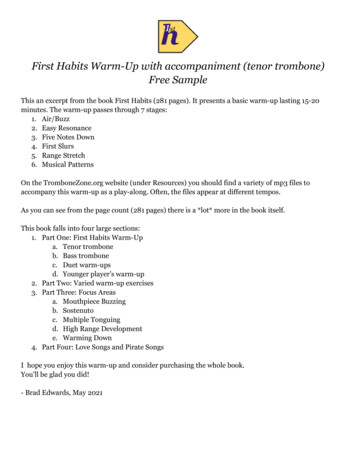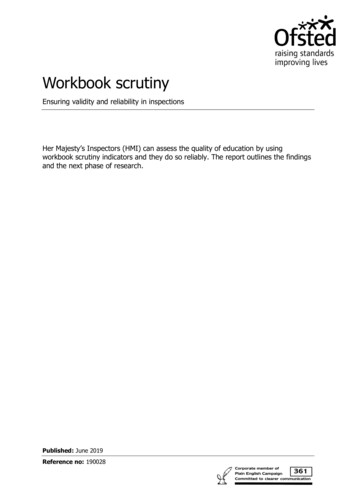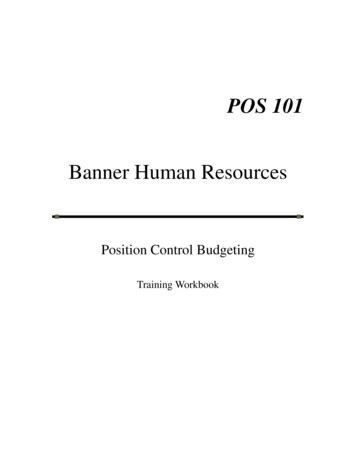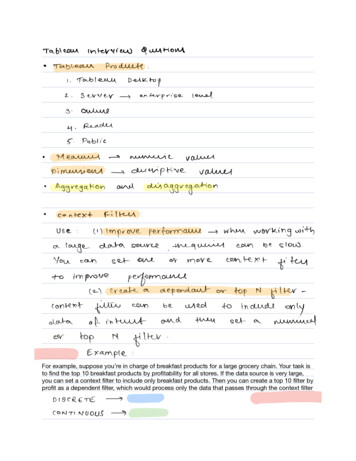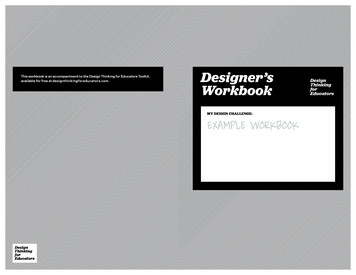
Transcription
This workbook is an accompaniment to the Design Thinking for Educators Toolkit,available for free at r’sWorkbookWorkbookDesignThinkingforEducatorsMY DESIGN CHALLENGE:EXAMPLE rEducators
What is Design Thinking?Design Thinking is about believing we can make a difference,and having an intentionalprocess in order to get to new,relevant solutions that createpositive impact.Design Thinking gives you faithin your creative abilities and aprocess for transforming difficultchallenges into opportunitiesfor design.Design Thinking talWelcome to theDesigner’s Workbook.This workbook includes step-bystep instructions for completinga design challenge using thedesign thinking process. thisworkbook is a quickstart guideto the design thinking processand is best used in combinationwith the design thiinking toolkitfor educators.The Design Thinking Toolkit forEducators contains in-depthinstructions and explanationsas highlighted by each step inthis workbook the toolkit alsoprovides you with examplesfrom educators, like yourself, ofhow they’ve been using designthinking in their work.THIS WORKBOOK CAN SUPPORT ANY DESIGN CHALLENGE YOUWANT TO TACKLE. THOUGH WE OFTEN SEE CHALLENGES THATCENTER AROUND A FEW SPECIFIC TOPICS:This workbook is an accompanymantto the Design Thinking for Educatorstoolkit, available for free atdesignthinkingforeducators.com.CURRICULUMEvery day you design ways tointeract with your students aroundcontent. You can follow a designprocess to be more intentionalabout connecting this content tothe interests and desires of today’slearners by finding out more aboutthe things that they do outside ofschool and connecting that to thecontent you are bringing to them.SPACESThe physical environment of theclassroom sends a big signalabout how you want your studentsto behave. Right now we tend tothink of our classroom spaces asstandard kids in rows, sitting indesks. By rethinking the designof our spaces, we can send newmessages to our students abouthow they should feel and interact inthe classroom.PROCESSES & TOOLSYour school has already designeda set of processes or tools thatmay or may not be setting upyour school for success. This istypically outside of the classroomand specific interactions aroundlearning, and more around how thesystem operates. Every process isalready designed, and thus can beredesigned! Sometimes creatingtools can be essential to supporting newly designed processes.SYSTEMSNot everyone can always make decisionsfor the system that they exist within, buteveryone can contribute to the design ofthat system. Designing systems is aboutbalancing the complexity of many different stakeholder needs with the needs ofthe operation. When designing systems,we’re often setting high-level strategysuch as stating visions, priorities, policies, and key communications aroundthese ideas.
Hello Designer!Whether this is your first design project oryour fiftieth, you are taking a brave stepto address challenges in your classroom,school or community by designing newsolutions that build from people’s needsand desires. Exciting!This workbook is meant to help youstructure your process and capture yourthoughts. Use it how it best helps you you can use some of the methods or all ofthe methods, it’s up to you.GettingStartedFirst step define your challenge andcreate a project plan.WHAT’S IN THIS SECTION0-1 Define a Challenge0-2 Create a Project Plan0–3 Create a Project Plan
DT for Ed0–1 Define a ChallengeGETTING STARTEDWorkbook670–1 Define a ChallengeDreams and Gripe SessionFinding opportunities for design often begins by noticing problems. Sometimes it comes out aswishes (“I really wish our school had .”) Sometimes it comes out as complaints (“It annoys methat we’re not .”) Either starting point is fine. You might want to try this with a friend shareNext, flip these statements into possible design challenges. Begin your question with “Howmight we ” or HMW for short. This turns the problems you see into opportunities for design!your dreams and gripes and ask them to reflect back design opportunities.DREAMS/THINGS I WISH WOULD EXISTI WISH I COULD COLLABORATE MORE WITH OTHER TEACHERS.GRIPES/THINGS THAT COULD BE BETTERHOW MIGHT WE HMW. CREATE NEW TOOLS FOR TEACHERS TO COLLABORATE?HOW MIGHT WE KIDS ARE SO ENGAGED ON THE COMPUTERS BUT I DON’T HAVE ENOUGH.HMW. REDESIGN MY CLASSROOM TO BETTER MEET THE NEEDSTHINGS WOULD BE BETTER NEWER TECHNOLOGY.OF MY STUDENTS?
DT for Ed0–2 Create a Project PlanGETTING STARTED8Workbook90–2 Create a Project PlanSketch out the End Goal(s)What will I work to produce?END GOAL(S)Establish ConstraintsWhat constraints will I need to manage?CONSTRAINTSPROTOTYPES I WILL TRY AND BUILDNEEDS TO FIT WITHIN MY CURRENT SCHOOL BUILDINGA PILOT PROGRAMBUDGET OF 5O DOLLARS FOR THE YEARA VISION DOCUMENT THAT I’LL SHARE WITH OTHERSHAS TO BE READY TO TRY WHEN STUDENTS RETURN FROM BREAKA “PITCH” PRESENTATION TO ENLIST OTHERS IN THE IDEASDefine Indicators of SuccessWhat measures and indicators will help me know my ideas are successful?MEASURESPOSITIVE FEEDBACK I GET FROM STUDENTSMY PRINCIPAL FUNDS FURTHER DEVELOPMENTOTHER TEACHERS WANT TO JOIN MEOTHER THINGS TO KEEP IN MIND
DT for EdGETTING STARTED0–2 Create a Project Plan10Write a BriefWrite up a short “brief” that clarifies the challenge you’d like to address. Write it as if you werehanding it to someone else to design with. Capture thoughts on why this is a problem, and what theopportunity for design will be.11How Might We!Capture the design challenge you’ve decided to work on CHALLENGE QUESTIONBRIEFWITH THE ATTENTION SPANS OF STUDENTS DECREASING, AND INCREASINGCOMPETITION WITH THE LATEST TECHNOLOGY, A 30 YEAR-OLD CLASSROOM,WorkbookHMW. REDESIGN MY CLASSROOM TO BETTER MEETTHE NEEDS OF MY STUDENTS?AND MORE STUDENTS BEING ADDED TO THE CLASSROOM EVERY YEAR, THEINCREASED CHAOS DOESN’T SERVE THE LEARNING EXPERIENCE. CLASSROOMSET-UP STRONGLY INFLUENCES LEARNING BEHAVIORS, THERE IS A BIGOPPORTUNITY TO REDESIGN MY CLASSROOM TO BETTER ADDRESS THENEEDS AND INTERESTS OF TODAY’S STUDENTS.WHAT KIND OF CHALLENGE IS THIS? (CIRCLE ONE)CURRICULUMSPACES!TIPKeep the challenge simpleand optimistic. Make it broadenough to allow you todiscover areas of unexpectedvalue, and narrow enough tomake the topic manageable.PROCESSESAND TOOLSSYSTEMS
DT for Ed0–3 Create a Project PlanGETTING STARTEDWorkbook12130–3 Create a Project PlanThe Design Thinking process is flexible and can integrate into your school structure andtiming. The process can be run in a day, a week, a year, or more. What you put into the challengedetermines what you get out of it. The depth of insight, opportunity areas, and level of conceptrefinement and impact will vary depending on the length of your project For now, choose thetimeline you’d like to begin working with. After getting started on the project, you may find thatyou’ll want to evolve this plan to meet the needs of your design solutions.8amINTERPRETATIONIDEATIONTO HELP ME WITH PLANNING, I WILL ENGAGE:BORROW RIMENTATIONEVOLUTION5pmalign schedules to conduct a challenge on a professional development day? Do you need to bookspace or request materials? Who do you want help from?BOOK ROOMDISCOVERYnoonWhat do you need to get in place to enable you to get started on this project? Do you need toCHECKLISTCircle your Design PlanDAYProject NTATION5pmEVOLUTIONJUNEJULYAUGUSTEVOLUTIONIn a DayIn a Week or TwoSpread out over MonthsSketch your TimelineCreate a timeline for your project. What are major dates you’ll be working toward? Do you need aprototype to be ready for use after summer break? Do you want to share learnings at parentteacher night or pitch your concept to the school board? Consider deadlines, meetings, andinterim check-in dates.TIMEI WANT TO COMPLETE THE FIRST ITERATION OF THIS PROJECT BY:
Great!You have now defineda design challenge tocreate new solutionsfor, and have sketcheda work plan for youand your team.1DISCOVERYNow you are ready tomove on to the firstphase of the designprocess. Discovery.WHAT’S IN THIS SECTION1–1 Understand the Challenge1–2 Prepare Research1–3 Gather Inspiration
DT for Ed1–1 Understand the ChallengeDISCOVERYWorkbook16171–1 Understand the ChallengeReview the ChallengeShare What you KnowWhat are some things your team identified about the current design challenge? Capture keyWhat do you believe you already know about this challenge? What would you like to learn morethoughts, constraints, and barriers from the discussion.about? Capture your assumptions, and your questions.THOUGHTS, CONSTRAINTS, BARRIERS- TOO MANY STUDENTS IN MY CLASSROOM, THERE’S ONLY ONE WAYTO FIT ALL THE DESKS IN THE ROOM- DON’T WANT TO GET RID OF SUPPLY OVERFLOW BUT I HAVEI ALREADY KNOW- STUDENTS DON’T LIKE CHANGE. THEY WOULD PREFER TO KEEP THEIRDESK LOCATION IN THE SAME PLACE THROUGHOUT THE YEAR.- BEHAVIOR CAN BE SHAPED BY CLASSROOM SET-UPNO WHERE TO STORE ITI WANT TO KNOW MORE ABOUT- BEST SET-UP FOR INDIVIDUAL STUDY VS. GROUP WORK- INTERESTING WAYS OTHERS MANAGE SPACE, PEOPLE & RESOURCES- PRIVACY IN A PUBLIC ENVIRONMENTDid your group rewrite the challenge after your discussion? If so, capture it here:HOW MIGHT WE.
DT for Ed1–1 Understand the ChallengeDISCOVERYWorkbook1819Build your TeamDefine your AudienceWho is on your team? Who are core members and who are extended members? Through yourWho will you be designing for? Consider the core audience and extended audience.discussion, what did you determine about the roles that people will play and the unique goals thatyou each have?Draw a visual reminder.CORE TEAM MEMBER(S)(ME)GOALS AND ROLESTEAM LEADER. TO LEAD A DESIGN PROCESSTHAT HELPS ME BETTER ENGAGE MY STUDENTS.AFTER SCHOOLACTIVITIES GROUPSWHO SHARE THESPACEEXTENDEDAUDIENCE(S)EXTENDED TEAM MEMBER(S)GOALS AND ROLESCOREAUDIENCE(S)STUDENTSTEACHERS THATMORE ATTENTIONCOLLABORATETHAT NEEDEXTENDEDAUDIENCE(S)PARENTS THATWANT TO COMEHELP IN THECLASSROOMUSE MY ROOM TO
DT for Ed1–2 Prepare ResearchDISCOVERYWorkbook20211–2 Prepare ResearchIdentify Sources of InspirationIdentify Places of InspirationWho are all of the people involved in your topic? Who might represent extreme behaviorsWhere can you go to have an inspiring experience related to your challenge? What are analogousrelated to your topic? Which experts do you want meet with to learn more about your topic?List the candidates that you think will provide the most inspiration and circle 3-5 that yousettings or extreme experiences where you might witness similar or relevant behaviors andactivities in a different context? List the as many locations as you can and circle 3-5 that you arewant to engage with first.most excited to observe first.USERS, EXPERTS, EXTREME USERSINSPIRING LOCATIONS, ANALOGOUS SETTINGSEXPERTS: INTERIOR DESIGNERS FOR OFFICES, BEHAVIOR EXPERT,WORKSPACE ON AN AIRPLANE, IKEA, GOOGLE, PIXARFENG SHUI MASTER, SPACE ORGANIZATION SPECIALISTSPEND TIMING WORKING & SITTING IN THE STUDENTS’ CHAIR,EXTREMES: HOME SCHOOLED CHILDREN, STUDENTS GOING TO DIFFERENT TYPESOF SCHOOLS, STUDENTS ATTENDING AFTER SCHOOL PROGRAMSIN A CUBICLE, AT A PLAYGROUND
DT for Ed1–2 Prepare Research22Workbook23Select Research ParticipantsWho specifically do you want to talk to and learn from? Create detailed descriptions forat least 3 different users or sources of inspiration. Be sure to cover a variety of gender,experience, ethnicity, etc.USER TYPEDISCOVERYHOME-SCHOOLED STUDENTUSER DESCRIPTIONUSER TYPEUSER DESCRIPTION13-17 YR-OLD STUDENT WHOSE PRIMARY LEARNING SPACE IS NOT IN A FORMALCLASSROOM. LEARNING MIGHT TAKE PLACE IN EXPERIENTIAL LOCATIONS SUCHAS AN OUTDOOR BIOLOGY AND GEOLOGY CLASS, IN A MUSEUM, AT AN OFFICE,OR THROUGH REMOTE MEANS. INTERVIEW TO TAKE PLACE IN ONE OF THESELEARNING LOCATION OR AT THE STUDENT’S FAVORITE STUDY SPOT. WOULDLOVE TO SEE BACKPACK, FAVORITE BOOK, OR LEARNING TECHNOLOGY.USER TYPEUSER TYPEUSER DESCRIPTIONUSER DESCRIPTION
DT for Ed1–2 Prepare ResearchDISCOVERYWorkbook2425!Build a Question Guide: InterviewWhat do you want to learn to better understand the challenge at hand? What are you hopingto understand about people’s motivations and frustrations? What do you want to learn abouttheir activities?START SPECIFICWhat are some specific questions you can ask toopen the conversation?GO BROADWhat are some questions that can help you start to understand this person’s hopes, fears and ambitions?INTERVIEWEE NAMEJOHN, AGE 16TIPMake a copyof this for eachinterview.PROBE DEEPWhat are some ways you might be able to dig deeper in the conversation,,to find even more of the perspective this person has?TELL ME A BIT ABOUT WHAT YOUDRAW YOUR LEARNING SPACE FORTELL ME A STORY ABOUT A TIME WHEN YOU FELTDID IN CLASS DAY.ME AND TELL ME WHAT YOU LOVESPACE. WHAT HAPPENED? WHO WAS THERE? WHY DID YOU FEEL SO GOOD?AND WHAT YOU DON’TREALLY GOOD IN THIS
DT for Ed1–2 Prepare ResearchDISCOVERYWorkbook26Build a Question Guide: ObservationWhat are you looking to learn in this observation? Capture themes and questions that you wantto make sure you get to in the site visit! Fill in one of these worksheets for each observation, sothat you can consider what you will ask for each place you are visiting.THINGS TO SEEWhat are some things you want to make sure you observe while you are visiting this place?27!OBSERVATION SITESTARBUCKS COFFEE SHOPTIPMake a copyof this for eachobservation.THINGS TO DOWhat are some things you can do to gain inspiration in this place?HOW DO PEOPLE INTERACT WITH INFORMATION IN DIFFERENT LOCATIONS?PRETEND I AM WORKING ON A BIG PAPER AND TRY TO GET COMFORTABLEWHERE DO PEOPLE SEEM TO FOCUS BEST OR LIKE TO STUDY?ENOUGH TO STUDY AND FOCUS. WHAT DO I NEED?
DT for Ed1–2 Prepare Research28CHECK LISTAssign responsibilities before going into the field. Who is in charge of confirming date, time, andlocation of the research activities? Who is responsible for making sure you have all the necessaryequipment? Who will take the lead in interviewing? In documenting?QUESTION GUIDEPARTICIPANTS CONTACT DETAILSTEAM MEMBERS’ CONTACT DETAILSMEGROLEINTERVIEWERDIRECTIONS TO LOCATIONNOTEPADS AND PENSCAMERA (CHECK BATTERIES!)MOBILE PHONESTHANK YOU GIFTS FOR PARTICIPANTS(IF APPLICABLE)POST-IT NOTES, SHARPIE MARKERSLOCATION OR INTERVIEWEEJOHN SMITHWorkbook29Prepare For FieldworkTEAM MEMBERDISCOVERYADDRESS, DATE AND TIME123 MAIDEN LANE, JAN 12, 4:30PM
DT for Ed1–3 Gather InspirationDISCOVERYWorkbook30311–3 Gather InspirationInspiration NotesNAME OF PERSON INTERVIEWED/LOCATION VISITEDJOHN SMITH, HIS BEDROOM AND WORKSPACEOBSERVATIONS AND QUOTESAS YOU ARE INTERVIEWING,capture what you see and hear duringa field visit. Capture direct quotes.Separate your observations from yourinterpretations so that you know what yousaw and what you thought it meant for!TIPFill this out ofthis for eachinterview.that person.Look for work-arounds and adaptationspeople have made to make a system toserve their needs better such as booksstacked under a laptop to make thescreen a better height for viewing.INTERPRETATIONS- JOHN KEEPS EARPHONES AT HIS DESK- I THINK MUSIC HELPS JOHN FOCUS WHILE STUDYING- “I’M VISUAL, SO I USE PINTEREST WHEN I’M WRITING A PAPER.”- I THINK JOHN LEARNS BEST THROUGH VISUAL CONTENT AND WANTSMORE OPPORTUNITIES TO SURF THE WEB WHILE HE IS WORKING IN SCHOOL.
DT for Ed1–3 Gather InspirationDISCOVERY32331–3 Gather InspirationInspiration NotesNAME OF PERSON INTERVIEWED/LOCATION VISITEDSTARBUCKS, NEAR THE UNIVERSITYOBSERVATIONS AND QUOTES-THE CAFE MOSTLY HAS ONE PERSON AND ONE LAPTOP PER TABLEWorkbookTIPFill this out ofthis for eachobservation.AS YOU ARE INTERVIEWING,capture what you see and hear duringa field visit. Capture direct quotes.Separate your observations from yourinterpretations so that you know what yousaw and what you thought it meant for!that person.Look for work-arounds and adaptationspeople have made to make a system toserve their needs better such as booksstacked under a laptop to make thescreen a better height for viewing.INTERPRETATIONS- PEOPLE LIKE TO WORK IN PUBLIC BUT STILL WANT THEIR OWN SPACE.
Through the Discovery phase, you havegained deeper understanding, empathy,and inspiration foryour design challenge.2INTERPRETATIONThrough, Interpretation, the second phaseof the design process,you will now makemake meaning anddefine insights fromyour Discoveryobservations andinterviews.WHAT’S IN THIS SECTION2–1 Tell Stories2–2 Search for Meaning2–3 Frame Opportunities
DT for Ed2–1 Tell Stories36INTERPRETATIONWorkbook372–1 Tell StoriesCapture Your LearningsWhat did this participant care about the most?What motivates him/her?Immediately after interviewing, be sure to capture your learnings. Capture one observation, storyhighlight or quote per post-it note. Use the prompts to guide you.WHO DID YOU MEET? (PROFESSION, AGE, LOCATION, ETC)JOHN, 16, HIS HOUSEWhat was the most memorable and surprising story?JOHN FOCUSES BEST AT A COFFEE SHOP, NOT THE LIBRARYBECAUSE SOME STIMULUS KEEPS HIM FROM ZONING OUT.What was interesting about the way he/sheinteracted with his/her environment?What frustrated him/her?What questions would you like to explorein your next conversation?
DT for Ed2–1 Tell Stories38INTERPRETATIONWorkbook39Learnings from my partner/team:Share Inspiring StoriesTake turns sharing stories of the peopleyou talked to or the places you visited.While listening to your team, capture theirLearnings from my partner/team:stories and observations on post-it’s, usinga separate post-it per thought. Capture themost interesting learnings here.Learnings from my partner/team:Learnings from my partner/team:Learnings from my partner/team:Learnings from my partner/team:
DT for EdINTERPRETATION2–2 Search for MeaningWorkbook40412–2 Search for MeaningFind ThemesMake Sense of FindingsLook for themes, patterns and connections across your wall of post-it notes. Cluster relatedTake a closer look at your themes and find overlaps, patterns and tensions as they relate to eachpost-it’s around themes that you notice. It’s like moving your thoughts around and seeing newpatterns as a result. Create headlines for each category that capture these themes and patterns.other. Can you group several related themes in larger categories?HEADLINES- STUDENTS FEEL A LACK OF PRIVACY NECESSARY FOR STUDYINGWHEN IN THE CLASSROOM.WHAT ARE THE LARGER CATEGORIES?- FLEXIBILITY- STUDENTS WANT PRIVACY BUT ALSO ACCESSIBILITY TO HELP- STUDENTS DESIRE A VARIETY OF DESK/TABLE WORK OPTIONSWHILE STILL HAVING OWNERSHIP OVER PERSONAL DESKS.- THE CURRENT CLASSROOM DOESN’T ENCOURAGE STUDENT COLLABORATIONAS THERE IS NO WHERE FOR THEM TO WORK TOGETHER.Did you find any contradictions? Did you haveany unexpected learnings or find somethingthat felt surprising? Why?UNEXPECTED LEARNINGSAfter having discussed with your team, and/orgotten feedback on the categories, what areyou excited to dig deeper into?I AM EXCITED TO EXPLORE.- CREATIVE WORK PLACES CHANGECREATING A STUDY SPACE THAT’STHEIR SPACE CONFIGURATION OFTEN.QUIET ENOUGH FOR FOCUS BUT- STUDENTS FEEL THEY CAN STUDYACTIVE ENOUGH TO KEEP STUDENTSBEST WHEN AWAY FROM THEIRSTIMULATEDNORMAL DESKS.
DT for Ed2–3 Frame OpportunitiesINTERPRETATIONWorkbook42432–3 Frame OpportunitiesDefine InsightsMake Insights ActionableInsights are a concise expression of what you have learned from your research and inspiration.Actionable and successful ideas start withThey are the “aha” moments and unexpected learnings.the right question, which identifies importantopportunities through great INSIGHTS.Sometimes, it can be helpful to write an insight in the form of a Point-of-View (POV) statementwhich makes an insight specific to user or user group. A simpler way to create a POV is throughthe POV equation.user need interesting learning POVINSIGHT/POVJOHN NEEDS A BALANCE OF PRIVACY AND STIMULUS TO STUDY BECAUSEHE FOCUSES BEST WHEN THERE IS SOME ACTIVITY TO KEEP HIM FROMRemember, each “How might we” (HMW)question will only address a portion of yourchallenge so you can create multiple HMW’sand prioritize them for ideation.!TIPAvoid brainstormquestions that alreadyimply a solutionIs your question.BROAD ENOUGH TO SPEAK NOW IDEAS?NARROW ENOUGH TO FEEL MANAGEABLE?FOCUSED ON RESPONDING TO YOURUSER-DRIVEN INSIGHT?GETTING TOO BORED.HOW MIGHT WE.INSIGHT/POVINSIGHT/POVINSIGHT/POV- HOW MIGHT WE MAKE A CLASSROOM FEEL LIKE A HOME STUDY SPACE?- HOW MIGHT THE CLASSROOM CUSTOMIZE ITSELF FOR EACH INDIVIDUAL?
DT for Ed2–3 Frame OpportunitiesINTERPRETATIONWorkbook44Create a Visual ReminderFrameworks, diagrams, and illustrations are great tools forcommunicating insights or complex information.45THINGS TO TRYMap out the network of connectionspeople, actions, objects, interactions.Illustrate activity or information flow.Map the actual/figurative journey thatpeople or things take.SKETCH OR CREATE A VISUAL THAT WILL HELP EXPRESS YOUR INSIGHTS.Journey mapVenn diagramTwo-by-twoRelationship map
Now that you’ve created a point-of-view andframed opportunitiesfor your design challenge, you are readyto move to the thirdphase of the designprocess.Ideation!3IDEATIONIdeation will help youcome up with manypossible design solutions to address yourchallenge.WHAT’S IN THIS SECTION3–1 Generate Ideas3–2 Refine Ideas
DT for EdIDEATION3–1 Generate IdeasWorkbook48493–1 Generate IdeasPrepare for BrainstormingA successful brainstorm session requires planning. The small details matter. Invite a diversegroup of people who can stay open-minded and can build on each other’s ideas. 6-10 is ideal for abrainstorm. Who will you invite?NAMESCHECK LISTSELECT A FACILITATORPRESENT YOUR TOPICINTRODUCE THE RULESOF BRAINSTORMINGEQUIP EVERYONE TO PARTICIPATESTART WITH A WARM-UPMOVE ONE BY ONEKEEP THE ENERGY HIGHPOST ITSSNACKS(never underestimate the powerof sugar in a brainstorm!)Sufficient wall space is necessary to have room for everyone to get up and see each other’sideas, and will leave you with room to post plentiful ideas. Where will you conduct the brainstormand how will you set-up the space to facilitate a brainstorm?MARKERSBRAINSTORM RULES1. DEFER JUDGEMENT2. ENCOURAGE WILD IDEAS3. BUILD ON THE IDEAS OF OTHERS4. STAY FOCUSED ON TOPICROOM SET-UP5. ONE CONVERSATION AT A TIME6. BE VISUAL7. GO FOR QUANTITYPOST THE BRAINSTORM RULES.PAPER
DT for Ed3–1 Generate IdeasIDEATION50Workbook51Facilitate BrainstormingCreate, or use some of the suggested some warm-up brainstorm questions from the FacilitateBrainstorming method to get people in the right mood. Which questions will you use?WARM-UP QUESTIONS- HOW MIGHT WE FIND A NEEDLE IN A HAYSTACK?- “NEVER COULD WE EVER.” THINK OF THINGS YOU COULD NEVER DO ATSCHOOL, UNDERWATER, IN A TUXEDO.Feeling stuck?Here are a few other things to try:Add constraintsChange the magnitude of the solution space, usingsize, price, time commitments, and count. Ask yourself,“What if it was larger than this room? smaller than apeanut? took 5 years to implement? took 1 minute?was available for all? available for only a few?”Use inspiring brands.Ask yourself, “How would McDonald’s, Nike, Apple,Urban Outfitters, or Disney do it?”Make it time-specificAsk yourself, “What if it were made for the morning?night?”Which topic will you focus your brainstorm on?TOPICPERSONAL SPACE CUSTOMIZATIONWhich HMW brainstorm questions will you use?HOW MIGHT WE.- HMW DESIGN THE CLASSROOM TO CUSTOMIZE ITSELF FOR EACH INDIVIDUAL?Hone in on a target audienceAsk yourself, “What if it were only for tweens? kids?athletes? parents?”
DT for Ed3–1 Generate Ideas52IDEATIONWorkbook53Select Promising IdeasAfter you brainstorm, cluster any related ideas and have the team picktheir 3 favorite ideas.Collect the post-its of the favorite concepts from the brainstorm.Include the sketches if applicable. Which ideas received the most votes?FLIP UP DESK
DT for Ed3–1 Generate IdeasIDEATIONWorkbook5455Ask other group members for feedback about their favorite part of your sketch as well as aspectsSketch to ThinkPick one of the favorite ideas from the brainstorm, and flesh out the concept througha quick sketch or two.where they see room for improvement. What did they say?NOTES
DT for Ed3–2 Refine IdeasIDEATIONWorkbook56573–2 Refine IdeasDo a Reality CheckWhat is at the core of your idea: what gets youMake a list of all the challenges and barriersStarting from the list you created in step one of this worksheet page, describing the core valuesexcited about it? What is the most importantvalue for your audience? What is the real needyou are facing with your idea. What are youmissing? Who would oppose the idea? Whatof your idea, what are other ways in which you could address the needs differently?that this is addressing?will be most difficult to overcome?VALUE, NEEDS- LETS STUDENTS HAVE PRIVACY INPUBLIC SPACE- ENABLES STUDENTS TOCHALLENGES, BARRIERS- NOT ENOUGH HELP OR FUNDING TONEW CONCEPTS- IF STUDENTS NEED PRIVACY, MAYBE I CAN REARRANGE MY ROOM TO GIVEHACK ALL THE DESKS IN MY ROOMTHEM A SENSE OF PRIVACY WITHOUT HAVING TO BUILD NEW DESKSTO WORK THIS WAYINSTEAD OF MODIFYING ALL THE DESKS, MAYBE WE PROTOTYPE A LARGERCOLLABORATE USING EXISTINGCOLLABORATION TABLE THAT CAN STOW AWAY IN MY ROOM WHEN NOT INDESKSUSE (LIKE A FOLDING TABLE)- LETS STUDENTS KEEPPERSONALIZED DESKS
DT for Ed3–2 Refine IdeasIDEATIONWorkbook5859WHAT NEEDS OR OPPORTUNITIES DOES THE CONCEPT ADDRESS?Describe Your IdeaCreate a concept description for the idea that you would like to prototype and repeat for each idea.CONCEPT NAME:FOLD-UP LEAF-DESKLETS STUDENTS HAVE FLEXIBILITY TO COLLABORATE IN THE CLASSROOM BUTALSO PUT UP THEIR “DESK BLINDERS” WHEN THEY’RE TRYING TO FOCUS.ENABLES STUDENTS TO CONTINUE TO HAVE PERSONALIZED DESKS THATALLOW FOR FLEXIBLE WORKSTYLES.SKETCHONE-SENTENCE CONCEPT DESCRIPTION:THE MURPHY DESK, FOLD UP THE LEAVES FOR PRIVACY, FOLD OUT TO CREATEEXTENDED DESK SPACE FOR COLLABORATION.WHO DOES IT INVOLVE, BOTH IN BUILDING AND IN USING IT?HOW DOES IT WORK?ADD A HINGE AND DESK LEAF TO EACH DESK TOP. THE LEAF WILL FOLD UPTO OFFER STUDENTS PRIVACY WHEN THEY’RE TRYING TO BE HEAD’S DOWN, OR- HELP FROM A WOODWORKER, SOMEONE WHO CAN SEW AND/OR HANDY-MANVOLUNTEER PARENTS- CLASSROOM STUDENTS AND AFTER-SCHOOL ACTIVITIES GROUP WILL BENEFITFOLD OUT TO GIVE THEM MORE WORKSPACE WHEN THE STUDENTS WANT TOWORK AS A TEAM. ADD CASTERS TO THE DESK SO STUDENTS CAN EASILYMOVE THE DESK AROUND FOR COLLABORATION. DESK CUSHIONS!WHAT DO YOU HOPE TO LEARN MORE ABOUT THROUGH PROTOTYPING THIS IDEA?TEST THAT THE IDEA WORKS ON A FEW DESKS TO GET FUNDING FOR THEENTIRE CLASS.
You have now generated lots of ideas andchosen a few conceptsto move forward.In the fourth phase ofthe design process—Experimentation—youwill prototype inorder to bring yourconcepts to life.4EXPERIMENTATIONWHAT’S IN THIS SECTION4–1 Make Prototypes4–2 Get Feedback
DT for Ed4–1 Make PrototypesEXPERIMENTATIONWorkbook62634–1 Make PrototypesTake PhotosSince your prototype should be out in the world, take photos of it and place them here.SOME THINGS TO TRYCREATE SEPARATESIMPLER PROTOTYPES“Works like” (how the back end functions), “acts like” (how the “front-end”interaction works), and/or “looks like”(how it looks).Place photo herePlace photo herePlace photo herePlace photo herePTRY “EXPERIENCEPROTOTYPES”Have people roleplay or bodystormusing props and prompts.SHRINK BIG THINGS DOWNUse scale models and mockups.GO 2DUse storyboards or diagrams.
DT for Ed4–2 Get FeedbackEXPERIMENTATIONWorkbook64654–2 Get FeedbackIdentify Sources for FeedbackSelect Feedback ParticipantsHow do you need to test your prototype in order to receive the most relevant feedback? Can youWho do you want to engage in the feedback process? Who will you learn the most from? Includelet people experience your prototype without further explanation by leaving it in various places?Do you need to walk people through the experience of your prototypes? What will your testingpeople you have met during your field research as well as new participants.session look like?I WILL TEST BY.FEEDBACK PARTICIPANTSASKING STUDENTS TO USE DURING STUDY HALL OR AFTER-SCHOOL WHEN MYJOHN SMITHCLASS ISN’T AS BUSYWOODWORKERWhat about your idea do you need to test? What kind of feedback do you need in order to iterateand refine your idea? What is the most important question you want to ask? Are you tryingto learn whether people would participate in a new activity you designed? Are you wonderingwhether people will change behaviors over time because of your concept?LIST FEEDBACK GOALSWANT TO KNOW IF THE PRIVACY BLINDERS MAKE THE STUDENTS FEEL MORELIKE THEY’RE WORKING FROM THE COMFORT OF THEIR HOME WITH PRIVACY.WANT TO SEE IF THE ADDED SURFACE SPACE ENABLES MORE COLLABORATION
DT for Ed4–2 Get FeedbackEXPERIMENTATIONWorkbook6667Build a Question GuideIt is likely that as you have made your idea tangible, you have developed questions about how theINTERVIEWEE NAMEprototype should work, what people are interested in, how to best engage participation, etc. Listany questions that have been bubbling up about your concept. During your feedback session,you’ll want to ask for specific feedback about your idea. What would you like to know more about?START SPECIFICWhat are some specific questions you can ask toopen the conversation?GO BROADWhat are some questions that can help you start to understand this person’s hopes, fears and ambitions?PROBE DEEPWhat are some ways you might be able to dig deeper in the conversation,,to find even more of the perspecitive this person has?TIPFill this out ofthis for eachinterview.!
DT for Ed4–2 Get Feedback68Use these prompts to help people give you co
a design challenge using the design thinking process. this workbook is a quickstart guide to the design thinking process and is best used in combination with the design thiinking toolkit for educators. The Design Thinking Toolkit for Educators contains in-depth ins

